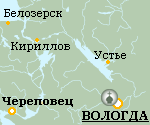 | ||
The Saviour Transfiguration Cathedral of the Saviour Priluki MonasteryIn 1545, Ivan the Terrible came here to worship and in 1552, preparing for the Kazan campaign, he took the Kilikievsky cross from the monastery  Search | ||
 |
|
The Saviour Priluki (Spaso-Prilutsky) Monastery. The Saviour Transfiguration Cathedral. 1503
 A view of the Saviour Priluki Monastery |
The Saviour Priluki Monastery which is close to Vologda was founded in 1371 by St. Demetrios, a hegumen from Pereslavl-Zalessky, a disciple and follower of St. Sergius of Radonezh. St. Demetrios of Priluki built the first wooden church and wooden cells for monks.
The cloister acquired its name from the principal Church of the All Merciful Saviour and the winding of the river (luk) on which bank the monastery stands.
The St. Saviour Priluki Monastery was famed as the oldest and largest monastery in the north of Russia. The monastic charter, which insisted on no private property, obedience to the hegumen, labour for the good of the cloister and joint meals in a refectory, was strictly observed. In 1392, St. Demetrios passed away and was buried near the southern wall of the wooden Saviour Cathedral.
 St. Demetrios of Priluki with scenes from his life. Dionisy and his studio |
The monastery was supported by blessed Dmitry Donskoy whose son was baptized by St. Demetrios of Priluki. Afterwards, grand princes and tsars never ceased providing support and donations. It is known for a fact that prior to his Kazan campaign Ivan III ‘demanded’ the icon of St. Demetrios of Priluki that was considered miracle-working. After the victory he adorned it with silver and gold and returned it to the monastery on June 3 1503.
Repeatedly, grand princes and tsars visited the monastery for worship. In 1528, Grand Prince Vassily II with his wife Elena Glisnkaya came to the monastery to pray for a child. In 1545 Ivan the Terrible came to worship and in 1552, when preparing for the Kazan campaign, he took the Kilikievsky cross from the monastery.
Moscow princes and tsars along with other wealthy people donated lands, money, church vessels and objects to the Saviour Priluki Monastery. Owing to the support of grand princes and spiritual experience of hegumens, the cloister developed and prospered.
Up to the 16th century, all the constructions in the monastery were wooden. As it turned into a large, influential and prosperous monastery of northern Rus, stone construction began. In 1537-1542, a stone cathedral in honour of the All-Merciful Saviour and the feast of the Vivifying Cross was erected. At the turn of the 16th and 17th centuries the monastery carried out other stone construction, notably a refectory chamber with the Church of the Presentation of the Blessed Virgin and the main (northern) Holy gates with the Church in the name of Holy Great Martyr Theodore Stratilate.
At the beginning of the 17th century, during the Time of Troubles, the monastery underwent numerous attacks and pillages. It was then that a considerable part of the old archives was destroyed. Despite the devastation and fires the monastery quickly recovered. During the second half of the 17th century, a thick stone wall with towers as well as a new tall belfry and service buildings were built. Subsequently, in the 18th and 19th centuries, there was hardly any construction.
In the 19th century, the Saviour Priluki Monastery was regarded as the stronghold of Orthodoxy in the North. The fact that in 1812, before the Napoleon invasion, all relics and treasures of Moscow cathedrals and monasteries were brought here speaks for itself.
From 1924 to 1991 the monastery was shut. Now the monastic community is being revived. Various workshops (including iconographic) are functioning within the monastery. There is also a Sunday school for boys and a library. The Vologda Orthodox religious school is located in the territory of the cloister.
Experts know of around ten cathedrals whose walls were painted by Dionisy. Some of the painter’s works are lost for good; some have been preserved by restorers
Only the wall painting of the Virgin Nativity Cathedral of the St. Ferapont Belozero Monastery has survived in full and intact |
|
According to historical documents, the following works of Dionisy (the dates indicate the year of their painting) are known:
|
See also: |
|
|
 |
SUPPORTING WITH:
| |||||||||||||








